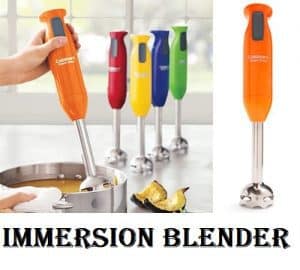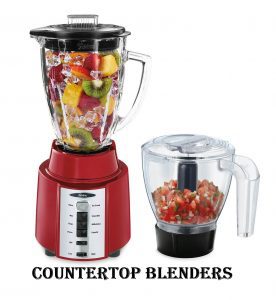Different Kinds of Blenders
Blenders are becoming increasingly popular today because of their ease of use, easy cleaning and their utility in so many of our kitchen tasks. Many blender manufacturers are competing in the market with newest technologies and improved functionalities of their products. Many different types of blenders are available differing in their appearance, size, power, functionality and consequently their price. However, there are two broad categories available: immersion blender and countertop blenders.
Immersion Blender:
 Immersion blenders, also called hand blenders or stick blenders are a very handy piece of blending tools which provide their utility in a long list of recipes. You can use them in making soups (which they are best known for) as well as smoothies and milkshakes, sauces, dips, humus, pancake and waffle batter and the list goes on and on.
Immersion blenders, also called hand blenders or stick blenders are a very handy piece of blending tools which provide their utility in a long list of recipes. You can use them in making soups (which they are best known for) as well as smoothies and milkshakes, sauces, dips, humus, pancake and waffle batter and the list goes on and on.
It is a handheld device with blades at its base. You can immerse the blender shaft in the mixture that you want to blend. One of the principal benefits of these kinds of blenders is that they can blend hot liquids right in the pan. You don’t have to wait for the mixture to cool. This makes it an ideal choice for making soups and sauces. They take up minimum space in the kitchen which makes them an ideal choice for small kitchens. Another plus point is that they are very easy to clean. The detachable blending shaft can be washed easily in a dishwasher or by hand.
They mostly include a tall pitcher to blend the ingredients in. The cheaper ones come with little or no attachments apart from the blending jug and are suitable for only the basic blending tasks. They have a motor power between 150 watts to 250 watts which are unsuitable for handling heavy processing tasks like those involving hard foods.
If you go for pricier versions, you have a lot of choices available with multiple attachments for example chopping and whisking. These high-end immersion blenders also have higher motor powers around 300 to 600 watts to provide their utility in a wider range of tasks. Some also have multiple speed options to provide more precision in blending tasks. Cordless varieties of hand blenders are also becoming quite famous. Then there are also commercial heavy duty hand blenders with even higher motor powers and longer shafts to allow processing in bigger, deeper dishes.
Countertop Blenders:
 Countertop blenders, also known as jug blenders or jar blenders are also very useful blending tools which generally come with greater motor power as compared to immersion blenders and can process heavier foods like ice (though not all countertop blenders come with ice crushing capabilities). They are ideal for making smoothies and milkshakes but also provide their utility in making baby food, sauces, soups, whipped cream, pancake batter and more.
Countertop blenders, also known as jug blenders or jar blenders are also very useful blending tools which generally come with greater motor power as compared to immersion blenders and can process heavier foods like ice (though not all countertop blenders come with ice crushing capabilities). They are ideal for making smoothies and milkshakes but also provide their utility in making baby food, sauces, soups, whipped cream, pancake batter and more.
A wide variety of these types of blenders are available in the market. They range from small personal ones that have a low motor power and can handle only the simplest blending tasks to heavy duty commercial ones with motor powers as high as 700 watts. These high powered countertop blenders can handle tough tasks like crushing ice and making nut butter. Blender speeds can range from 3 speeds to as high as 16 speeds. Greater speed options add precision to the blending task.
Another type of countertop blenders are smoothie blenders which perform better than personal blenders and are less expensive as compared to commercial blenders. On the downside, the smoothie blenders have a more limited functionality as compared to personal blenders which can be used for making dips, sauces and other things besides smoothies. Smoothie blenders only excel in making smoothies and milkshakes.
Conclusion:
In conclusion both types of blenders, immersion and countertop are very useful and provide their utilities in a wide variety of kitchen tasks. Both types have their own strong suits. If you have a greater budget you might want to get one of each type. If, however, you are on a strict budget, you will have to consider the differences and make a choice depending on your own preferences. You will have to keep in mind why you need one in the first place, how much space you have available in your kitchen and your budget.
